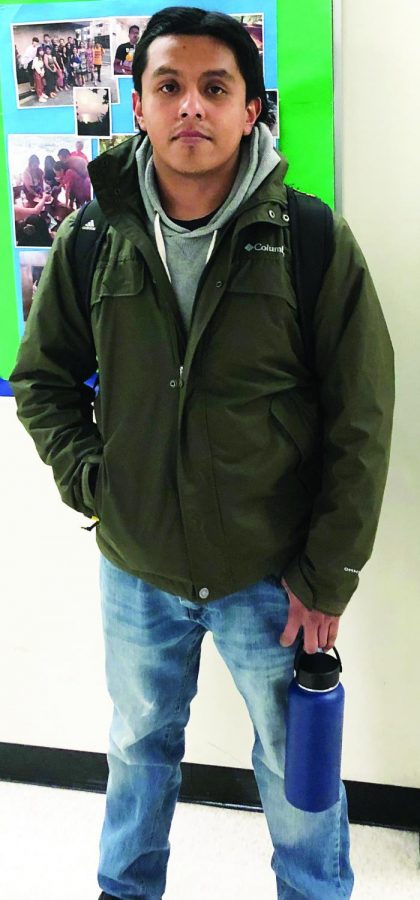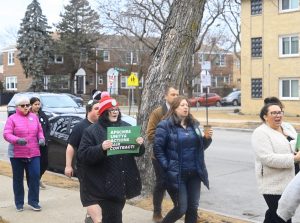Student Veterans Club reinvigorated with new leadership
Gabriel Can of SVC have big plans such as the restoration of the Peace Garden outside the cafeteria with the NEIU GCG.
February 25, 2020
“We’re not what you see in the movies,” the newly-elected 23-year-old president of the Student Veterans Club (SVC), Gabriel Can, says about veterans. Just last semester, the Student Veterans Club had only two members. But according to staff advisor Anne Ortiz, the club is well on its way to rebuilding. On Jan. 23, the SVC elected a new cabinet: Can, Vice President Daniel Firszt, Secretary Daniel Lim and Treasurer Enki Younan.
When The Independent spoke with Oritz, she explained that the SVC was almost deemed inactive due to low membership. Ortiz hopes to rebuild the Student Veterans Club and inspire students to take a more active role in managing the club and its affairs.
Can grew up in the Pilsen neighborhood of Chicago, Ill., before serving in the United States Marine Corps for four years as a corporal and a small arms technician. As a noncommissioned officer (NCO), Can was responsible not only for the training and management of his junior-enlisted subordinates but also for several million dollars worth of government equipment. Today, he’s a sophomore studying psychology and hopes to earn a master’s degree in psychology with an emphasis on substance abuse rehabilitation.
Can’s goal as president of the SVC is to encourage our university’s veterans to assume an active role in the future of the university. He also urges veterans and nonveterans alike to support the SVC by joining their ranks. The only requirement for joining the SVC, he points out, is to support the veteran community.
The SVC advocates for veterans and assists with the academic and social success of student veterans. Despite the skills and training many veterans possess, they are identified as a vulnerable population by a 2016 study from the Centers for Disease Control and Prevention. Veterans are often overlooked and forgotten except during election years.
A prime example is the Phoenix VA scandal of 2014. Veterans had complained for many years about average wait times of 3 months to see a primary care manager (PCM). These complaints were often dismissed as exaggerated.
Then in 2014, a rare event occurred. 107 elected positions at the State level were due for election. It was then that CNN began asking why 40 veterans had died while waiting an average of 115 days to be seen by the VA. Suddenly, many investigations were launched simultaneously on the Department of Veteran Affairs and hidden waitlists were discovered as well as a conspiracy to hide those lists.
According to the Department of Veteran Affairs and the National Institute of Health, many suffer from homelessness, PTSD, suicidal ideations and divorce, often at the same time.
Can and his team have big plans for the SVC. They have already begun by increasing membership to about 15 active members (14 veterans and 1 nonveteran). The SVC hopes to recruit many of the approximately 250 military-connected students currently attending NEIU as well as nonveterans.
The SVC is working on a collaboration with the NEIU Green Conservation Group to restore and update the Peace Garden. These restorations include planting new plants as well as installing a plaque and eventually a monument.
President Can and Treasurer Younan have been working with John “JB” Butler, the director of Corporate and Foundation Relations, to locate grants to help accomplish these missions.
The SVC’s biggest goal for the near future is establishing a veterans’ resource center. This is not intended to be just a hangout spot, but more of a relaxed place to do homework, network and to conduct workshops.
Many skills and experiences that veterans may have acquired do not translate easily when transitioning to the civilian sector. While Transition Assistance Programs are adapting to encompass these issues, many veterans are left behind. While their skills may put them at an advantage, the disadvantage of not being able to translate those skills outweigh any benefit.
As of Jan. 2020, the Department of Labor reported veteran unemployment at 3.1%. This figure does not include veterans that are not receiving unemployment benefits. Marketplace.org clarifies that labor force participation for U.S. veterans is 49.7%, which means that more than 10 million veterans are currently unemployed or actively receiving unemployment benefits.
Despite not being provided a location, the SVC cites that President Gloria J. Gibson as supportive of these projects. Students that wish to join the SVC should visit the Veterans Service Center in room D130 for more information.







